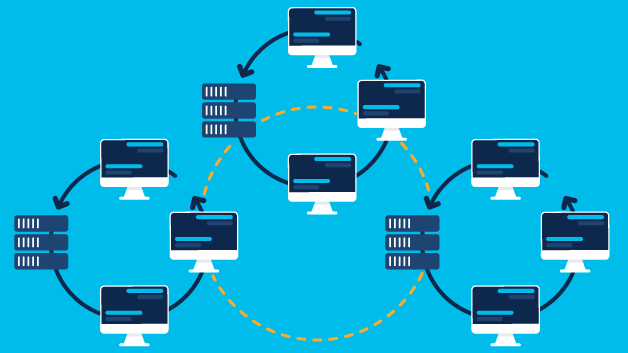Tech
Why Traditional WANs Are No Longer Secure Enough

Traditional WANs have become the go-to platform for data networking, voice, and IT infrastructure. They use a hybrid of leased and public lines and Virtual Private Networks or MPLS routers for security.
However, they have their limitations. These limitations include security issues and management difficulties.
Cost
As business trends and technological advancements push digital production boundaries, organizations rely on network-centric computing to power efficient and quality output. This means that a solid and reliable WAN connection is a critical part of delivering quality service to employees across the globe.
Traditionally, WANs incorporated hard-wired connections to route IP services. These connections typically included a variety of layers of the underlying hardware that required heavy planning, logistics, and expertise to install.
This was a time-consuming and expensive process. Additionally, it introduced additional delays and costs when a network provider had to re-provision the line at a new location.
However, these issues can be easily solved using a modern software-defined WAN like those provided by Versa Networks. By utilizing flexible WAN connectivity options, SD-WANs offer lower costs and bandwidth efficiency.
Another significant advantage of an SD-WAN is that it allows clients to scale their WAN connection plans based on actual demand. For example, if the number of employees increases, the WAN can be scaled up to support a surge in traffic without needing to improve the physical capacity at each site.
Also, the centralized configuration of the WAN reduces the amount of “configuration drift” between branch offices, making it easier to add new application services without negatively impacting existing services. These benefits make SD-WANs an attractive solution for many enterprises.
Scalability
Traditional WANs must be more secure as the business moves beyond the enterprise to the cloud. The explosion of WAN traffic caused by cloud adoption has introduced management complexity, unpredictability in application performance, and data vulnerability.
Network topologies have changed because cloud computing disperses applications and data to end devices rather than converging around a single hub and spoke network design. This requires a new approach to network connectivity and is driving the need for Software-Defined Wide Area Networking (SD-WAN).
A centralized bandwidth pool from multiple service providers, SD-WAN uses the internet for branch-to-branch interconnectivity with significant application performance, especially for mission-critical apps, while providing consistent security across various locations. It also simplifies WAN operations, lowers costs, and provides a seamless on-ramp to the cloud.
Another critical factor limiting the scaleability of traditional WANs is the number of hardware devices required to support them. This makes it difficult to expand or restructure the WAN as branch offices, or remote locations require additional equipment, which often adds cost to the business.
The solution is SD-WAN, which combines the functionality of traditional WAN technologies with broadband internet and software-defined networking (SDN). This software-driven technology lets you control WAN traffic, prioritize data, and connect multiple networks from a central console.
Security
Network traffic has increased as organizations have moved their data to the cloud. This requires that network managers monitor, control, and prioritize all incoming traffic as it moves across the network.
In the past, this was a very challenging task for traditional WANs to manage. It required a lot of planning, logistics, and machinery to monitor incoming traffic and make real-time changes.
Another problem with traditional WANs is that they rely on multiprotocol label switching (MPLS) networks, which are expensive and require long lead times to deploy to new locations. Also, as internet traffic increases, it causes an overload of MPLS links.
This can cause many problems for businesses that need to track and prioritize their network traffic, like companies that handle high volumes of data. SD-WAN can help mitigate this by implementing routing rules that direct all incoming traffic to one or more connections with the most reliable bandwidth available.
Security measures common to SD-WAN solutions include firewalls, usually next-generation firewalls (NGFWs), that offer malware detection, anti-virus protection, application monitoring, SSL inspection, web content filtering and intrusion detection and prevention. They should also be able to support internal communications, ensuring that endpoints and devices are adequately protected from cyber threats as they move about your network.
Availability
WAN technology has long been a staple in IT, voice, and data networking, connecting multiple locations through routers and Virtual Private Networks (VPN). It is used to link large companies that have offices across different cities.
Traditional WANs rely on a mix of public and leased lines, often with Multiprotocol Label Switching(MPLS), which gives an efficient and resilient traffic flow. It also allows for the prioritization of data, video and VoIP(voice over IP) services.
As organizations migrate to the cloud and workload-bearing applications, they need a more flexible and dynamic network. However, legacy WANs need to be more suited to this challenge.
The traditional WAN approach was designed in an era when the focus was on linking physical locations. That means expensive global connectivity and complex topologies that take more work to maintain and secure.
Another disadvantage is the need for extensive planning and logistical support to deploy new sites. This is especially true in a mobile workforce, where new offices are frequently located away from their primary offices and must be connected.
Fortunately, SD-WAN provides the flexibility of a software-defined approach that evolves a traditional WAN into a more agile network to support the demands of cloud and workload-bearing applications. In addition, a software-as-a-service model reduces CapEx requirements by moving the expense to an OpEx monthly charge.

Tech
Boost Your Telegram Channel Promotion with KYG’s Services

Telegram channels are powerful tools for businesses aiming to enhance brand awareness, share valuable content, build active communities, improve customer relationships, and boost sales. However, effective telegram promotion and management requires strategic efforts. This article explores how KYG’s services can support your Telegram channel promotion, leveraging advanced tools and strategies to maximize engagement and growth.

Services for Telegram Channel Promotion
Creating engaging content is critical for any social media platform. On Telegram, diverse content types such as text, media, and polls can captivate your audience. KYG’s services can assist in developing a content strategy that resonates with your target audience. With tools to set clear objectives and KPIs, KYG ensures you monitor key metrics and adjust your strategy based on performance and feedback.
Cross-Promotion Tactics
Expanding your reach through cross-promotion is vital. KYG supports cross-promotion efforts by providing insights into the most effective platforms for your audience. Whether you’re leveraging other social media channels or partnering with similar communities, KYG’s analytics help identify and optimize these opportunities, ensuring you attract engaged and interested users.
Influencer Partnerships
Influencer marketing is indispensable for boosting engagement and communication. KYG’s platform aids in identifying influencers who align with your brand values and target audience. By facilitating clear collaboration proposals and tracking campaign results, KYG ensures that your influencer partnerships are both effective and measurable, driving more users to your Telegram channel.
Exclusive Offers and Contests
Offering exclusive content and running contests are proven methods to boost engagement. KYG can streamline the process of advertising these offers across various platforms, ensuring maximum visibility. Additionally, KYG’s analytics tools help monitor the effectiveness of these campaigns, providing valuable insights for future strategies.
Consistent Communication and Engagement
Maintaining an active community requires consistent engagement. KYG’s community management tools make it easier to plan and track communication efforts. By providing comprehensive analytics and personalized recommendations, KYG helps ensure that your Telegram channel remains vibrant and engaging. Responding to comments, rewarding active members, and monitoring community health are all simplified with KYG.
Why Choose Know Your Group
KYG offers a comprehensive suite of tools and services designed to support effective Telegram channel promotion. With KYG, you get:
- Advanced Analytics: Monitor engagement, growth, and performance with precision.
- Customizable Community Portals: Tailor your community space to reflect your brand’s identity.
- Streamlined Onboarding: Easily integrate new members into your community.
- Monetization Tools: Turn your engagement into revenue with various monetization strategies.
- Expert Support: Benefit from personalized recommendations and strategic growth insights.
Know Your Group ensures your Telegram channel thrives, driving engagement and achieving your business goals.
FAQs
What is the best way to create engaging content for a Telegram channel?
Utilize diverse content types like text, media, and polls, and tailor your content to your audience’s interests and needs. KYG’s tools can help set clear objectives and track content performance to make necessary adjustments.
How can KYG help maintain consistent communication on Telegram?
KYG’s tools streamline communication planning and tracking, making it easier to engage with your community regularly. Their analytics provide insights to improve engagement strategies continuously.
What makes KYG a good choice for Telegram channel promotion?
KYG offers a comprehensive suite of tools for community management, including content strategy, cross-promotion, influencer partnerships, and engagement tracking, all tailored to help your Telegram channel succeed.
Tech
Coingama Exchange Review

Coingama is emerging as a premier cryptocurrency exchange platform, designed to cater to both beginner and seasoned traders. With its user-friendly interface, advanced security measures, and comprehensive trading tools, Coingama aims to provide a seamless and secure trading experience. This review delves into the various features and benefits that make Coingama a standout choice in the crowded cryptocurrency exchange market.
User Experience: One of the defining features of Coingama is its intuitive and easy-to-navigate interface. The platform is designed with user experience in mind, making it accessible even for those new to cryptocurrency trading. The registration process is streamlined, allowing users to set up their accounts quickly and start trading without unnecessary delays. The dashboard is well-organized, providing users with all the necessary tools and information at their fingertips. Additionally, Coingama offers a mobile application, enabling users to trade on-the-go with the same level of efficiency and security as the desktop version.
Security Measures: Security is a paramount concern for any cryptocurrency exchange, and Coingama excels in this area. The platform employs a range of advanced security measures to protect users’ funds and personal information. These include two-factor authentication (2FA), encryption, and the use of cold storage for the majority of users’ assets, which significantly reduces the risk of hacking. Coingama also conducts regular security audits and updates to ensure that its security protocols remain robust and up-to-date. Users can trade with confidence, knowing that their assets are safeguarded by some of the most advanced security measures in the industry.
Trading Features and Tools: Coingama offers a comprehensive suite of trading features that cater to a wide range of traders. The platform supports numerous trading pairs, including major cryptocurrencies such as Bitcoin, Ethereum, and Litecoin, as well as various altcoins. This wide selection allows traders to diversify their portfolios and take advantage of different market opportunities. Coingama also provides advanced trading tools, including real-time charts, technical indicators, and market analysis, which help users make informed trading decisions. The platform’s trading engine is designed for high performance, ensuring fast and reliable execution of trades even during periods of high market volatility.
Liquidity and Fees: Liquidity is a crucial factor for any exchange, and Coingama ensures ample liquidity across all trading pairs, allowing for smooth and efficient trading. The platform has partnered with several liquidity providers to maintain tight spreads and minimize slippage. When it comes to fees, Coingama is competitive, offering a transparent fee structure with no hidden charges. Trading fees are kept low to attract more users, and there are various incentives and promotions available that further reduce the cost of trading on the platform.
Customer Support: Reliable customer support is essential for any trading platform, and https://coingama.com/ excels in this area as well. The exchange offers 24/7 customer support through multiple channels, including live chat, email, and a comprehensive FAQ section. The support team is responsive, knowledgeable, and dedicated to resolving any issues that users may encounter. This level of support ensures that users can trade with confidence, knowing that assistance is readily available whenever needed.
Educational Resources: Understanding the importance of education in trading, Coingama provides a wealth of educational resources for its users. The platform offers tutorials, webinars, and articles that cover various aspects of cryptocurrency trading, from basic concepts to advanced strategies. These resources are designed to help traders enhance their knowledge and improve their trading skills, making Coingama an excellent choice for both learning and trading.
Conclusion: In conclusion, Coingama is a reliable and efficient cryptocurrency exchange that offers a comprehensive trading environment. Its user-friendly interface, robust security measures, advanced trading tools, ample liquidity, competitive fees, and excellent customer support make it an attractive option for traders of all levels. Whether you are just starting out in the world of cryptocurrency trading or are an experienced trader looking for a dependable platform, Coingama provides the features and support needed to succeed. With its commitment to security, innovation, and user satisfaction, Coingama is well-positioned to become a leading player in the cryptocurrency exchange market.
Tech
Exploring the World of possiblyethereal

possiblyethereal is not just another online platform; it’s a digital sanctuary for seekers of wisdom, inspiration, and connection. Let’s delve into what makes possiblyethereal a unique and enriching experience for its visitors.
What is possiblyethereal?
At its core, it is a multifaceted platform that offers a blend of insightful content, community engagement, and personal development resources. It aims to transcend the mundane and explore the realms of the ethereal, sparking curiosity and fostering personal growth.
Content Categories on possiblyethereal
From thought-provoking articles to immersive multimedia experiences, it covers a wide range of topics. Whether it’s philosophy, spirituality, creativity, or wellness, visitors can find content that resonates with their interests and aspirations.
Unique Perspectives and Insights
What sets this apart is its commitment to offering unique perspectives and deep insights. Through diverse voices and unconventional narratives, the platform challenges conventional thinking and encourages exploration of the unknown.
Interaction and Participation Opportunities
Engagement is key at possiblyethereal, with opportunities for readers to interact through comments, forums, and collaborative projects. The platform fosters a sense of community where ideas are shared, discussed, and celebrated.
User-generated Content
A highlight of possiblyethereal is its emphasis on user-generated content. Visitors are encouraged to contribute their own stories, reflections, and experiences, creating a dynamic tapestry of collective wisdom and creativity.
Ethical Considerations and Transparency
In an era of digital information overload, It prioritizes ethical content creation and transparency. Clear policies ensure that content is authentic, respectful, and aligned with the platform’s values.
Personal Growth and Development
Beyond intellectual exploration, It offers resources for personal growth and development. From mindfulness practices to actionable insights, visitors can embark on a journey of self-discovery and empowerment.
Conclusion
It is more than a website; it’s a portal to a world of infinite possibilities and profound discoveries. Whether you seek intellectual stimulation, spiritual insights, or simply a sense of belonging, possiblyethereal invites you to explore, engage, and evolve.
FAQs
Can I contribute my own content to possiblyethereal?
- Yes, It welcomes user-generated content. You can share your stories, insights, and perspectives with the community.
What types of topics does possiblyethereal cover?
- It covers a wide range of topics, including philosophy, spirituality, creativity, wellness, and more.
How can I engage with the possiblyethereal community?
- You can engage by commenting on articles, participating in forums, and joining collaborative projects.
Are there resources for personal development on possiblyethereal?
- Yes, It offers resources such as mindfulness practices, actionable insights, and inspirational content for personal growth.
What are possiblyethereal’s policies on content creation and transparency?
- It maintains ethical standards in content creation and ensures transparency in information dissemination, aligning with its values of authenticity and respect.

 Others10 months ago
Others10 months agoDavid T Bolno: Why Giving Back To The Community Is So Crucial

 Travel10 months ago
Travel10 months agoPractical And Essential Car Interior Accessories To Add Comfort And Convenience To Your Drive

 Travel10 months ago
Travel10 months agoBusiness Visa for CANADA

 Business10 months ago
Business10 months agoTop Reasons Why you Need to Consider Outsourcing Real Estate Photo Editing

 Health10 months ago
Health10 months agoGarlic Is The Best Vegetable To Treat Heart Problems

 Business10 months ago
Business10 months agoDead And Co Setlist What They Played At The Gorge Amphitheatre

 Fashion10 months ago
Fashion10 months agoTips For Choosing The Right For Engagement Diamond Rings

 Tech10 months ago
Tech10 months agoThe Best Way to Never Get Lost: Buy Wayfinding Signs!